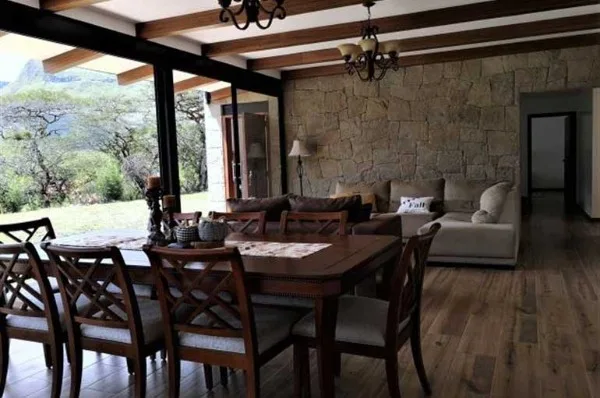How did Cuenca become the world’s greatest expat-lifestyle laboratory? A brief history of Ecuador’s and Cuenca’s expat boom and the post-Covid future
By Deke Castleman and Sylvan Hardy
We’re all Gary’s children.
Gringos lived and worked in Ecuador long before Gary and Merri Scott showed up in 1995, but the Scotts, almost single-handedly, put Ecuador on the radar screens of thousands of pilgrims to the Middle of the World. Almost all Cuenca expats can trace their knowledge of Ecuador as an expat destination back to Gary and Merri, even if they don’t realize it.
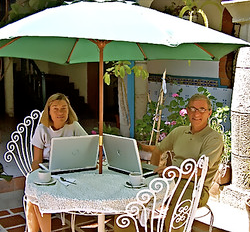
Merri and Gary Scott in Cotacachi.
In the very early 2000s, Gary was the first Ecuador correspondent for International Living, a magazine and internet service aimed at North Americans and other English-speakers considering moving overseas.
The Scotts were extraordinary although sometimes controversial marketers who, based on their travels and expat experiences, identified a growing trend of internationalism among the North American middle class. Gary, especially, experienced expat life in Hong Kong in the 1960s and London in the 1970s; he was a founding contributor to International Living way back in 1988.
When Gary and Merri arrived in Ecuador in the mid-’90s, they knew they’d discovered an opportunity of a lifetime. They’ve certainly capitalized on it, not only through real-estate investments, but also through various internet-based ventures. They’ve also sponsored real estate tours around Ecuador and shamanic tours into the rainforest, and held import-export and learn-Spanish-in-four-days seminars (and put on health and wealth retreats at their homes in Florida and North Carolina).
The Scotts banged the Ecuador drum for so long that by 2002 and 2003, the first wave of major media coverage washed up on the country’s shores.
The Rush to Ecuador
A handful of North Americans gravitated to Ecuador, especially Cuenca, in the early 2000s. In February 2004, when CuencaHighLife editor David Morrill moved here he found that a couple dozen expats from North American and Europe had preceded him, including Lee Harrison who succeeded Gary Scott as the Ecuador correspondent for International Living. “Back then, you could put almost all the expats in a single barroom, which is where most of them seemed to hang out,” he said.
By 2007, an estimated 300 to 400 resident expats had settled in Cuenca, many of them having married into Ecuadorian families.
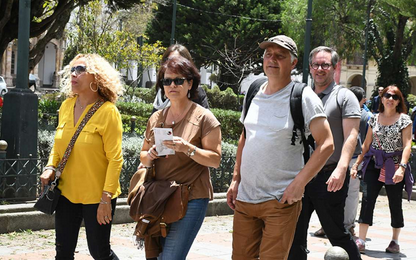
A group of prospective expats check out Cuenca in 2011.
Then, in 2008 Stern, Germany’s version of Newsweek magazine, rated Cuenca the best place to live in Latin American for foreigners, and National Geographic included Cuenca in its list of the world’s top 50 historic cities.
But Cuenca’s status as a world-class expat hot spot dates specifically to September 2009, when International Living named Cuenca the world’s number-one retirement destination. It was the first time International Living had bestowed the honor on a single city and not a country.
Morrill and former Cuenca resident Lee Harrison were writing for International Living at the time and probably played the biggest role in the number one ranking. Neither, however, thought they were playing a rankings game. “Our point was that Cuenca was a good place to live,” Morrill said. “We weren’t saying that it was the best and didn’t know about IL’s plan to name a champion. We’ve been blamed, or credited, however you look at it, for bringing thousands of gringos to Cuenca and that was never our intention,” he says.
The Cuenca story was quickly picked up by other publications and websites, including U.S. News and World Report, The Guardian, Conde Nast Traveler and USA Today, as well as most of the major television networks. In its 2012 Best in Travel guidebook, Lonely Planet named Cuenca one of the 10 top cities for travelers.
Also in 2012, Kathleen Peddicord, founding publisher of International Living and current publisher of Live and Invest Overseas, named Cuenca the world’s most affordable expat city in her popular book How to Retire Overseas.
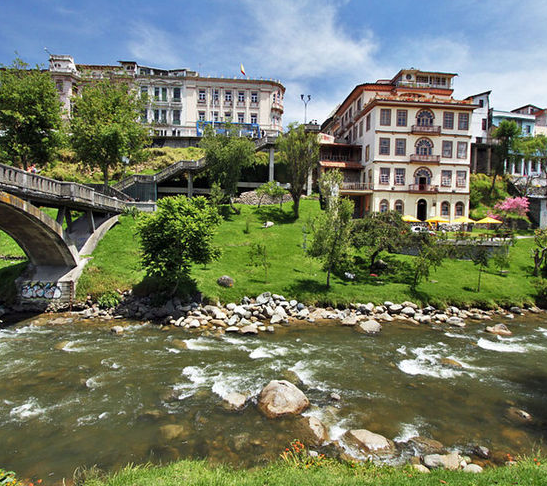
Many foreigners are attracted to Cuenca by the city’s culture and picturesque architecture.
The extensive worldwide coverage propelled thousands of gringos to Ecuador and especially Cuenca. From 2009, Cuenca’s North American expat population mushroomed, reaching an estimated peak of 8,000 in 2017 and 2018.
Although the North American invasion slowed considerably since then, and may have declined by 1,000 to 2,000, other expat groups have moved in to fill the void. The city of Cuenca Office of International Affairs estimates the number of legal foreign residents has remained steady at about 12,000 since 2017. The office says it is not including an estimated 10,000 Venezuelan refugees, most of whom who do not have legal status, in the number.
The number of Europeans, including Germans, French, Spaniards and Scandinavians, has tripled since 2015, according to former University of Cuenca demographer José Miller. Another trend, he says, is the rapid increase in the number of younger North Americans and Europeans, many of them with families. “My estimate is that 10,000 North Americans and Europeans currently live permanently in Cuenca,” Miller says.
He adds: “The expat population is becoming younger and more international which I think is to the benefit of the city as well as the expat community. I expect the trend to continue despite the interruption of the Covid pandemic.”
Real estate agents who work with foreigners agree with Miller’s assessment of expat trends. Graciela Quinde, who manages 60 rental properties, says the majority of her new tenants are not North Americans. “Two or three years ago, 80 or 70 percent were from the U.S. and Canada,” she says. “In 2020, it is less than 50 percent.” Among her November check-ins, she says, were Norwegians, Russians, Australians, Israelis and South Africans. “The market is changing because the expats are changing,” she says.
Why do expats come?
So what’s the attraction of Cuenca? Why do so many “first-generation” expats gravitate to the city, whether they are North American retirees or young European couples?
The answer is complicated, say Harrison and Morrill. “I tell people that it’s simply one of the best overseas destinations available,” says Harrison. “The infrastructure is good and getting better, the weather and culture are excellent and it’s easy to get to, especially from the U.S.” He adds: “The city is also the perfect size for a lot of people; large enough to have big city advantages but small enough to have a comfortable, homey feel.”
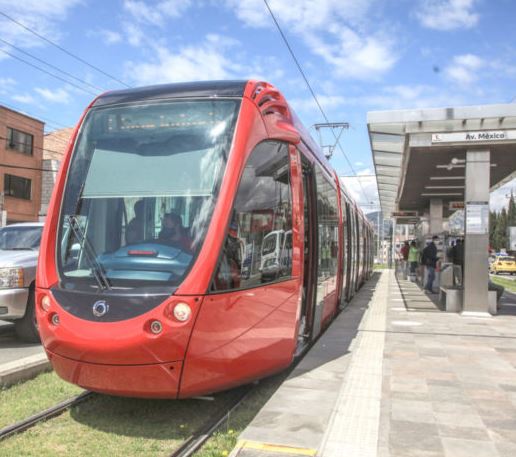
After years of delay, Cuenca’s new tram went operational in early 2020.
Morrill agrees, and says the improvements roads, law enforcement and other basic services in recent years has been impressive. The addition of the tram in May to the city’s transportation infrastructure is another notable milestone.
Of special interest to Morrill is the way the expat community grew in Cuenca. “It’s really the first Internet expatriation experiment,” he says. “Most of the earlier expat booms in Latin America were fueled, at least at the beginning, through the print media and television.” He includes San Migel de Allende and Ajijic, Mexico, Costa Rica, and Boquete, Panama in that group. “Cuenca’s foreign community was built almost entirely after the Internet had developed and that’s where the arriving foreigners got most of their information,” he says, adding that a number of academic studies support the premise.
There’s a downside to the online information that draws many expats, Morrill believes. “Because it’s so easy to get information online, and because there’s so much of it, it leads to sloppy research from sloppy sources, such as Facebook,” he says. “In the old days, people had to hunt down magazine articles and books to learn about places they were interested in. In many cases, they even went to the library, which today seems almost quaint. On the other hand, there was a higher degree of due diligence to the research because it took more effort to collect.”
“One of the results of the easy-to-get online information is that many people come to Cuenca and other expat communities unprepared to live in a different country,” he says. “That explains the spinning turnstile of expat comings and goings we see today.”
What comes after the pandemic?
Like practically every other aspect of life, the Covid-19 pandemic has had an unsettling impact on expat life. “It’s like someone pushed the pause button for the whole world,” Miller says.
“There seems to be a consensus that the working expat community, the people who are posted overseas by companies and consulates, will take years to recover to 2019 levels. On the other hand, most immigration experts think communities of expats who are not tied to employment will continue to thrive in the future. In fact, there’s pent-up demand because of the pandemic.”
He adds: “In the long term, I think Cuenca’s appeal to foreigners will remain strong. In fact, I think there will be new wave of expats coming to town once the virus is under control. It could be a year or two before we see it but I think it’s coming.”








